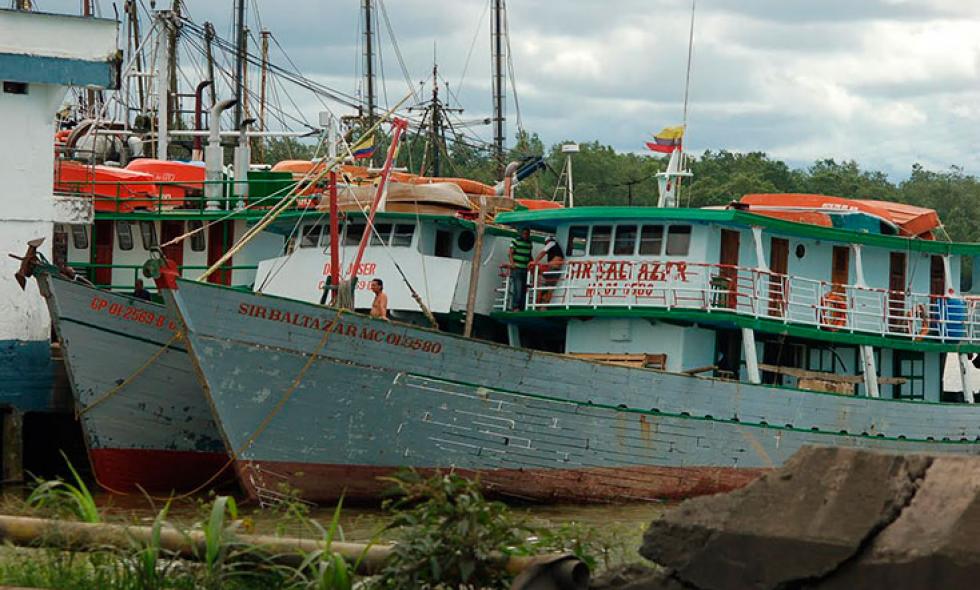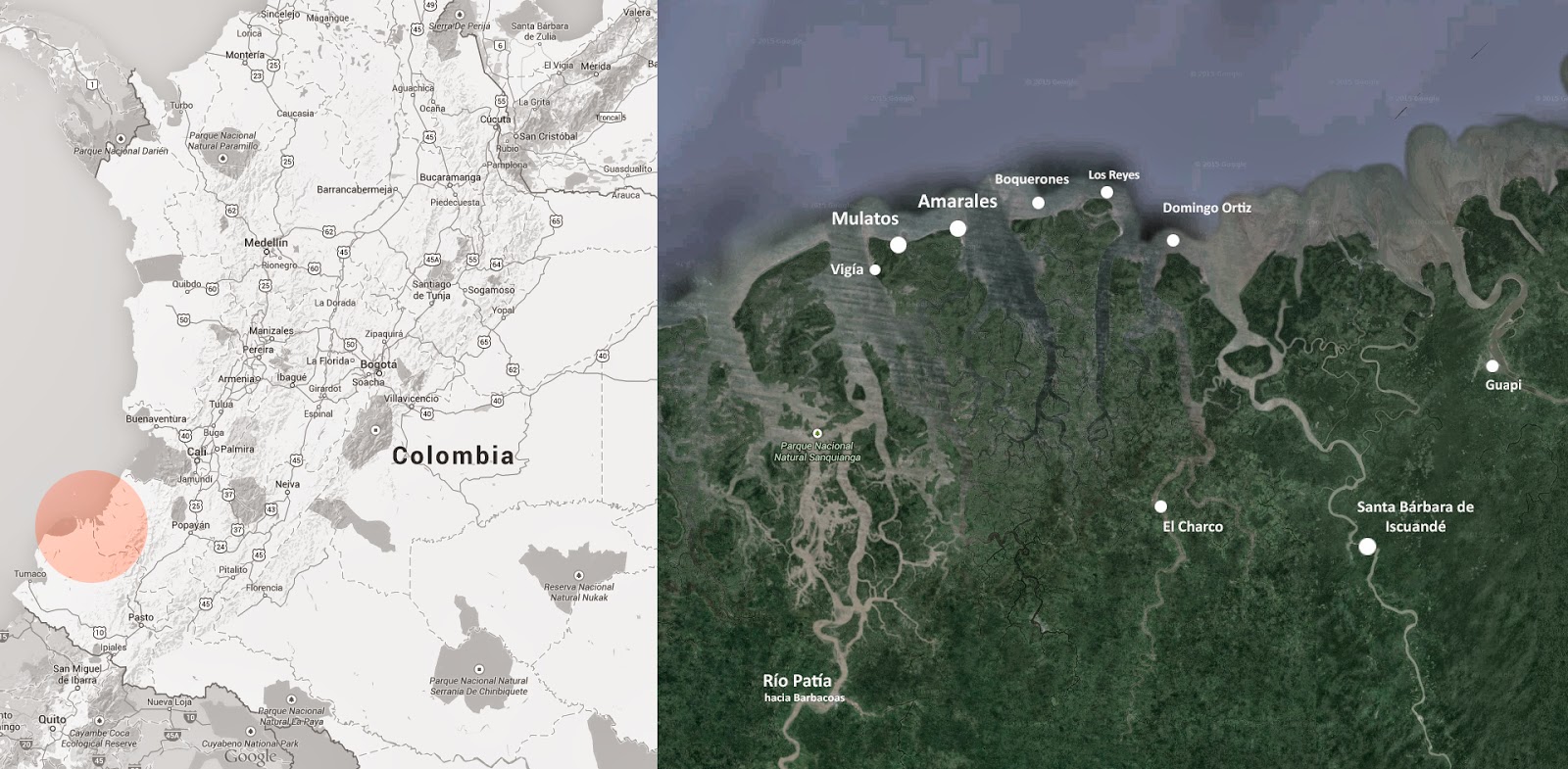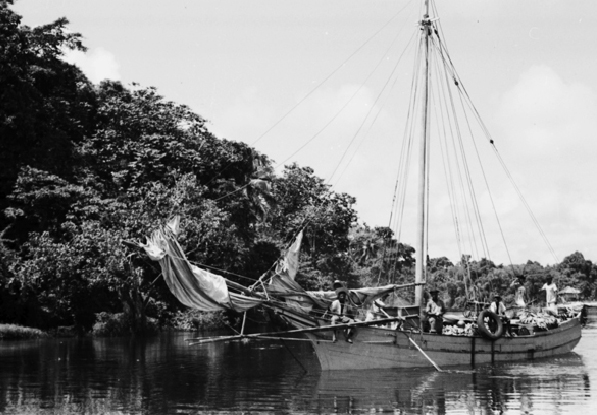Culimochos: the ships from Mulatos, Colombia
Elizabeth Parra and Rene Estupiñan
Team
Universidad Nacional de Colombia (Medellin): Facultad de Minas: Elizabeth Parra, estudiante Doctorado and Jaime I. Vélez, Docente; and Facultad de Arquitectura: Rene Estupiñan, estudiante Pre-grado, Fabián Zuleta, Docente.
Introduction
Mulatos is a small town, part of a network of habitats in the Pacific coast of Colombia.

Its inhabitants are known for their skills as navigators and naval carpenters. There are few studies about the origins, the history of the town, or that of its inhabitants, and even fewer is known about their ships. The Mungeños are a minority in the region, which is mostly inhabited by Afro-descendants, themselves also an ethnic minority in Colombia.
The presence of this group in Mulatos dates to 1789, the date of the public deed that determines the collective ownership over their territories (Arocha and Rodríguez, 2003). They probably arrived at the Mulatos beach from Iscuandé, a region in the southwestern coast of Colombia. Their migration probably started during the decline of the gold exploration period, which occurred in the Pacific of present-day Colombia during the 17th and 18th centuries (Rodríguez, 2002, Almario and Castillo, 1996).

The ships are known through iconographic data from travelers, at least since the mid-19th century, although oral tradition places the Mungeños on the Mulatos beach before, already building small ships for transport of goods and persons.

A handful of shipwrights still build and repair wooden boats in the region, practicing two types of construction: one with frames and ribbands (varetas), and one with half models and drawings.
The typical ships from Mulatos have up to 30 meters in overall length, are powered with diesel engines, and have a range of approximately 30 hours. They sail in the region carrying cargo and passengers between the ports of Tumaco and Buenaventura. The Mulatos’ shipyards, probably established in the early 19th century, are disappearing fast, victims of the social unrest caused by the war on drugs.
Objectives
This project aims at recording the history of the conception and construction of the culimochos de Mulatos over the three centuries of life of the coastal communities. Mulatos was probably populated by a mining community, which brought slaves to the region.
We want to try to understand who built the first culimochos of the Pacific coast of Colombia, based on which models, where the knowledge resided, how it was passed down through generations of shipwrights, what was their role in the community, what were the subsistence models of these maritime communities, and how were the vessels conceived and constructed, with what materials, and from where.
Together with the history of the Mulatos shipbuilders, we want to record, study, preserve, and share their culture and their shipbuilding skills, and understand their traditions and track the evolution of their techniques, tools, and design and construction solutions.
The People
Stella Rodriguez Caceres (2001) has written an ethnography of the culimochos, a word that designated both the ships and the population. In a paper with Jaime Arocha (2003), they state that “Los “culimochos” son «blancos» de piel; sin embargo, muchas de sus actitudes y comportamientos parecen de “negros”. Para empezar, habitan playas, bajos y esteros próximos a Satinga y El Charco en la costa pacífica, al norte de Nariño, fabrican y tocan marimbas, bailan currulao, cantan arrullos y hacen cocadas. Este pueblo había sido objeto de pocas aproximaciones etnográficas.”
The Ships
These ships are designed to carry cargo and passengers. They are presently built from lines drawings and construction drawings, which are approved by the competent authorities.
The lengths in the drawings are, however, marked in feet and inches. The Colombian pulgada was 1/32 of a vara of 0.84 m. This gives the dimension of a pulgada circa 2.625 cm. A pie is 28 cm and has 10.66 pulgadas. Colombia adopted the International System in 1854, and Spain in 1850.
The Shipyards
The shipyards are located on the beaches, in terrains with a gentle slope and enough space to setup the operations.
“Dentro del manglar El cauce seco de un caño que se llena de agua cuando sube la marea es el lugar donde siempre se han construido los barcos. Es allí, con la ayuda de nueve personas, donde cada pedazo de madera se encaja con el otro hasta llegar lentamente a hacer realidad el bolichero. Barcos que nunca han cambiado de diseño y siempre se han parecido a un Arca de Noé.”
https://www.eltiempo.com/archivo/documento/MAM-752930
Rene Estupiñan and the Shipwrights from Mulatos
Rene Estupiñan is one of the last shipwrights of Mulatos and is recording the methods learned within his family for posterity.
These ships are designed to carry cargo and passengers. They are presently built from lines drawings and construction drawings, which are approved by the competent authorities.
The culimochos are vessels with capacities between … and … built with wood and powered by diesel engines.
The owners are typically local residents…
The earliest references to this type of vessel appear in…
The vessels are built on permanent shipyards mounted..
The construction materials come from:
This shipbuilding tradition was greatly impacted during the drug wars and many shipwrights and ship owners lost their lives, their vessels, and even their shipyards in the conflicts.
The Tools
There is only one generator in Mulatos and the electricity is expensive and only available a few hour per day.
The ships are built with modern tools. Typically the timber comes from …
References
Almario, O. y Castillo R. 1996. “Territorio, poblamiento y sociedades negras en el Pacífico sur colombiano” En: Renacientes del Guandal: grupos negros de los ríos Satinga y Sanquianga. Editores: Del Valle, J. y Restrepo, E. Universidad Nacional de Colombia. Medellín.
Arocha, J., y Rodríguez Cáceres, S. 2003. “Los Culimochos: Africanías de un pueblo eurodescendiente en el pacífico nariñense”. En Revista Historia Crítica. PP. 79-94. Facultad de Ciencias Sociales, Departamento de Historia, Universidad de los Andes. Bogotá.
Rodriguez Cáceres, S., 2001. Piel Mulata, Ritmo Libre: Identidad y Relaciones de Convivencia Interétnica en la Costa Norte de Nariño, Colombia. Trabajo de grado para optar por el título de Antropóloga, Bogotá, Plan Curricular de Antropología, Facultad de Ciencias Humanas, Universidad Nacional de Colombia.
Rodriguez Cáceres, S., 2002. “Poblaciones blancas en el pacífico: historia y vigencia,” in Maguaré, 15-16: 114-135.Clayton, L., 1978. Los Astilleros de Guayaquil Colonial. Guayas, Ecuador: Archivo Historico de Guayas.
Rodríguez, S. 2002. “Poblaciones blancas en el pacífico: historia y vigencia” En: Revista Maguaré 15-16: pp.114-135. Publicación seriada Universidad Nacional de Colombia. Bogotá.
